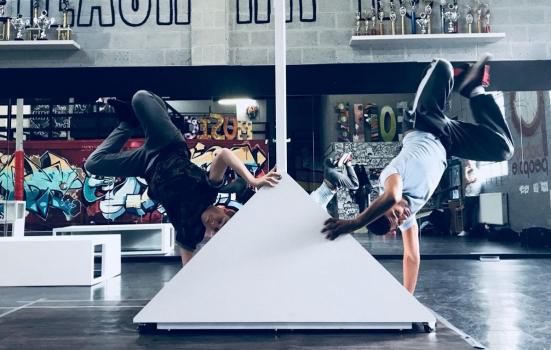Nathan Geering explains how a hip-hop dance production has helped give a voice to young people in the care system.

When I was first approached to be a creative mentor for Derbyshire’s Virtual School programme two years ago, I had no idea that it would have such a huge impact on my life and the work I would go on to make.
The youngsters were given the role of being the artistic consultants and would give feedback
Virtual School enhances the life opportunities for children in care in Derbyshire. Through the programme I met one 12-year-old girl who loved abseiling and arranged for us to abseil down a bridge. She asked that I go first and reluctantly I agreed. When I got half way down, I looked up and she was holding my rope. My life was literally in her hands.
That’s when it hit me. As adults and professionals, we expect kids to trust us even though they barely know us, but we rarely put ourselves in positions where we need to trust them. This inspired me to make a production that would give young people in care a voice – challenging stereotypes and attitudes towards them.
Production process
The Trust in Care production resulted from a collaboration for over a year, involving young people in care aged 12 to 19 and arts organisations. It combines hip-hop dance, interactive projection, contemporary dance, as well as poetry written by the young people themselves.
Young people were recruited by Virtual School and Derby Theatre’s Plus One scheme. Each young person was assigned a creative mentor to work together on artistic activities such as hip-hop dance, drama, interactive projection and aerial silks. The youngsters were given the role of being the artistic consultants and would give feedback. They’d tell us what they felt was a true reflection of their experience, and what wasn’t, and would give us directorial notes on how to improve each scene.
We collaborated with a cognitive behavioural therapist to help us identify the underlying themes and difficulties that each young person was dealing with. We did this by incorporating a five-part story method where they would create a fictional story including a hero, villain, quest, obstacle and resolution. The stories fed into the scenes and informed the narrative of the final production.
When working with vulnerable people we are always mindful of their mental health. Young people in care can often experience feelings of loneliness, anxiety and depression, so we worked with the therapist to develop a way to treat depression, anxiety and post-traumatic stress disorder through a combination of hip-hop dance and acceptance commitment therapy. Everyone involved in the creative process could access the arts-led therapeutic activity if they needed it.
Accessible features
As a company that puts accessibility at the forefront of our thinking when making productions, it was important that we educated and trained the young people on how to make the production accessible. After all, they will become our future leaders and will be creating an accessible future for generations to come.
We looked at how we could creatively integrate British Sign Language into the dramatic scenes and choreography, as well as how we could incorporate the Rationale method of audio description - which uses beatboxing sound effects to create a richer soundscape for people with visual impairments. In addition, the projection, costume and set were designed to be more visible to people with a visual impairment.
Sharing the success
We performed an excerpt of Trust in Care at Derby Theatre’s Culture Cares Conference in October during National Care Leavers’ Week. We also facilitated a panel discussion with the young people involved in the production to talk about their experience as artistic consultants and they gave physical demonstrations of how they helped to develop each scene. The event was a success as they represented themselves with such confidence and professionalism.
Trust in Care will be touring to theatres and we will continue to work with young people in care in every city we visit. They will also assist on the professional production in terms of direction, choreography, sound and lighting production, with the hope that in later runs of the tour they will manage aspects of the show to give them a deeper sense of ownership. By putting trust in our young people as a society we can all begin to show them that we truly care.
Nathan Geering is Artistic Director of Rationale Arts and Chief Executive of Rationale Method.
https://rationalemethod.com
View Trust in Care promotional video
The project received funding and business support from In Good Company through D2N2 Big House project to bring the production to stage, as well as funding from Plus One, Virtual School and Arts Council England.




